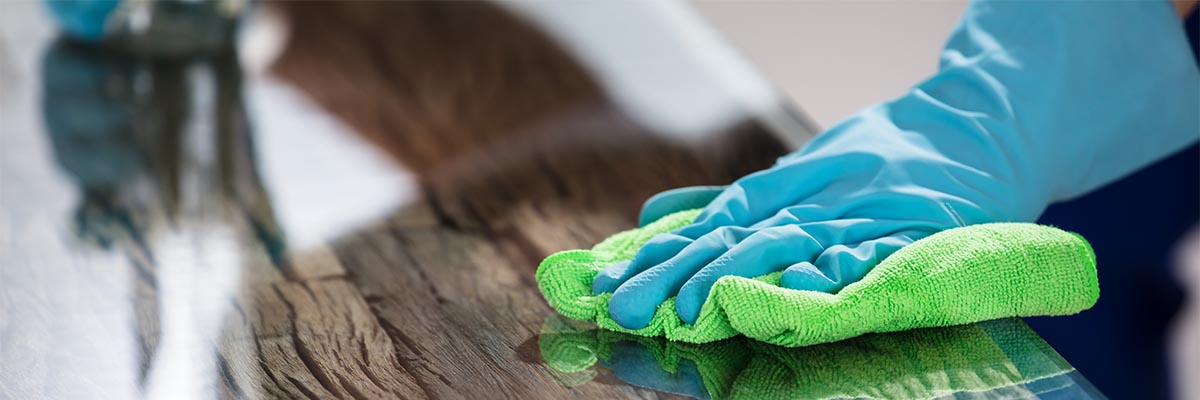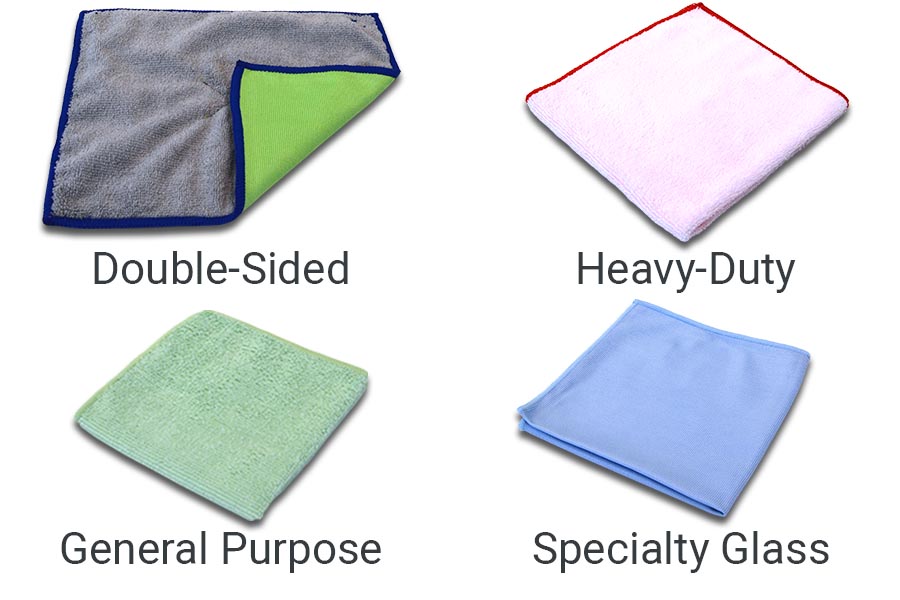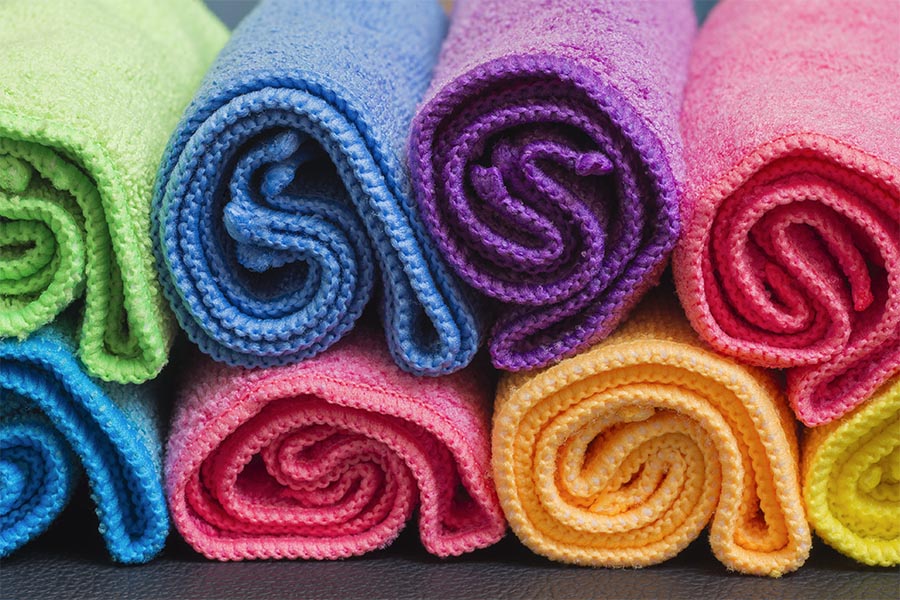Upgrade Your Cleaning With Microfiber Cloths
What Is Microfiber?
Microfiber is a synthetic material that is made up of very small fibers, typically smaller than a human hair. These fibers are woven together to create a soft, durable, and highly absorbent cloth. Microfiber cloths are designed to be versatile and can be used for a variety of cleaning tasks.
The unique structure of these cloths allows them to effectively trap and remove dirt, dust, and grime without the need for harsh chemicals. This makes them ideal for use on delicate surfaces like glass, electronics, and car interiors. They are also great for cleaning stainless steel appliances, countertops, and other surfaces in the kitchen and bathroom.
One of the key benefits of microfiber cloths is their ability to absorb liquids. They can hold up to seven times their weight in liquid, making them perfect for spills or cleaning up messes. Unlike paper towels, they are reusable and can be easily washed in warm water and detergent. This saves money and reduces waste and the environmental impact of disposable cleaning products.

In addition to their cleaning abilities, microfiber cloths are also known for their durability. They are designed to withstand repeated use and washing without losing their effectiveness. Many of them come with care labels that provide instructions on cleaning and maintaining them properly.
Microfiber cloths are available in various sizes, colors, and pack options, allowing users to choose the ones that best suit their needs. Whether you need a cloth for dusting, polishing, or general cleaning, they offer a reliable and eco-friendly solution.
How are microfiber cloths made?
Microfiber cloths are made through a specialized manufacturing process that involves splitting fibers to create microfibers, which are then knitted together to form a soft, reusable cleaning cloth. Here are the main steps involved in their production:
1. Fiber Splitting: The manufacturing process begins with regular fibers, usually made from polyester or nylon. These fibers are carefully split into ultra-thin strands, often as thin as 1/100th the diameter of a human hair. This splitting process helps create fine microfibers that give this cloth unique properties.
2. Knitting: Advanced machinery knits the microfibers together. The knitting process creates a dense fabric much finer than traditional cotton. This fine fabric helps to maximize the cleaning performance of the cloth.
Benefits of Microfiber Cloths
- Superior Cleaning Performance: Microfiber cloths are known for their exceptional cleaning abilities. The ultra-thin fibers effectively capture and remove dirt, dust, and grime from surfaces, leaving them sparkling clean. Unlike traditional cleaning materials, these cloths don't just push dirt around or spread it across the surface.
- Lint-Free Properties: Microfiber cloths leave no lint or residue behind, ensuring a streak-free and polished finish. This makes them ideal for cleaning glass, mirrors, and other delicate surfaces prone to streaks and lint when using other materials like paper towels or cotton cloths.
- Scratch-Free Cleaning: Microfiber cloths are safe to use on delicate surfaces. The soft and fine strands are gentle yet effective at removing dirt and grime without scratching or damaging the surfaces. Whether glass, stainless steel, or electronics, they provide a scratch-free cleaning experience.
- Environmental Benefits: Microfiber cloths are reusable and long-lasting, reducing the need for disposable cleaning materials and ultimately minimizing waste. With proper care, they can be washed up to 500 times.

Types of Microfiber Cloths
With a range of specific types available, microfiber cloths offer the versatility and effectiveness needed for various cleaning tasks, making them a popular choice for cleaning professionals.
Premium Double-Sided Cloths
Premium Double-Sided Cloths are the ultimate cleaning solution for various surfaces and tasks. These microfiber cloths feature a unique design with two sides, each serving a specific purpose.
One side of the cloth is designed for gentle cleaning and polishing. The soft and smooth texture is perfect for delicate surfaces like glass, electronics, and stainless steel. It effectively removes fingerprints, smudges, and dust without leaving any scratches or residue behind.
On the other side, a more abrasive texture is ideal for tackling tougher dirt and grime. This side is perfect for cleaning kitchen countertops, appliances, and other surfaces that require a more thorough cleaning. The abrasive side provides excellent scrubbing power without damaging the surface.
The Premium Double-Sided Cloths offer several benefits.
- Versatility: With two different sides, these cloths can handle various cleaning tasks and surfaces. From delicate electronics to heavy-duty kitchen cleaning, these cloths have you covered.
- Efficiency: The dual-sided design allows for efficient and effective cleaning. You can quickly switch between the gentle and abrasive sides, depending on the level of dirt and the surface you are cleaning.
- Durability: These cloths are made with high-quality microfiber designed to last. They are machine washable, making them a reusable and eco-friendly cleaning option.
- Superior cleaning performance: The premium microfiber material of these cloths attracts and traps dust, dirt, and debris, leaving surfaces clean and shiny.
Heavy Duty Cloths
Heavy-duty microfiber cloths are specifically designed to tackle challenging cleaning tasks and provide extra durability and scrubbing power.These cloths are made with high-quality, thick, and durable microfiber material. They are ideal for heavy-duty cleaning tasks and can withstand repeated use without losing effectiveness.
Benefits of heavy-duty microfiber cloths:
- Superior cleaning performance: The unique structure of microfiber traps and lifts dirt, dust, and debris, leaving surfaces clean and spotless.
- Long-lasting and reusable: Heavy-duty microfiber cloths are designed to withstand frequent use and can be machine washed for easy cleaning, making them a more sustainable option than disposable cleaning materials.
General Purpose Cloths
General-purpose microfiber cloths are a must-have for any cleaning arsenal. These versatile cloths are designed for general cleaning tasks and can be used on various surfaces, making them a convenient and cost-effective cleaning solution.
Using general-purpose microfiber cloths offers numerous benefits:
- Affordability: General purpose microfiber cloths are suitable for most tasks, making them an economical way to get superior results.
- Superior Cleaning Performance: The unique structure of microfiber cloths allows them to pick up even the smallest particles and debris, providing a thorough and streak-free cleaning experience.
- Reusability: General-purpose microfiber cloths are reusable, but do not last as long as heavy-duty products. This saves money in the long run and reduces waste and the environmental impact associated with disposable cleaning materials.
- Versatility: These cloths suit various surfaces and cleaning tasks. General-purpose microfiber cloths can handle everything from countertops to appliances, windows to bathroom fixtures.
Specialty Glass Cloth
Specialty Glass Cloth is a microfiber cloth designed to clean delicate surfaces such as glass and mirrors. With its unique features and benefits, this cloth ensures a streak-free and scratch-free cleaning experience.
Unlike ordinary cleaning cloths, the Specialty Glass Cloth is made with advanced microfiber technology that gently but effectively removes dirt, fingerprints, and smudges from glass surfaces without leaving any streaks behind. Its finely woven fibers are designed to trap and lift dirt particles, providing a crystal-clear finish every time.
The practical uses of this cloth are endless. It can be used to clean a variety of surfaces, including cell phone screens, windows, mirrors, laptops, TV screens, windshields, and chrome finishes. In addition to its exceptional cleaning performance, this microfiber cloth is also durable and long-lasting. It can be washed and reused countless times, making it a cost-effective and eco-friendly alternative to disposable wipes and paper towels.

Best Practices for Microfiber Cloths
Pretreating Microfiber Cloths
To pretreat a batch of microfiber cloths, follow these instructions.
- Load the desired number of cloths into a pre-treat bucket.
- Use the table below to determine the correct amount of solution for your cloth type. The amount of solution can be adjusted to match your preference. The amounts listed here will produce medium saturation levels.
- Add the pre-measured solution to the pre-treat bucket and seal it with a lid.
- Tip the pre-treat bucket upside down and wait for five minutes.
|
Solution Volume (Gallons) |
| Cloth Quantity |
Double Sided |
12 x 12 inch |
16 x 16 inch |
| 15 |
0.50 |
0.25 |
0.33 |
| 25 |
0.75 |
0.50 |
0.67 |
| 40 |
1.00 |
0.75 |
1.00 |
| 50 |
1.25 |
1.00 |
n/a |
Using All Eight Surfaces on a Cleaning Cloth
Using all eight surfaces on a microfiber cleaning cloth can greatly enhance its cleaning efficiency and extend its lifespan. Here are some steps to effectively use all sides of the cloth:
1. Fold the cloth into quarters: Start by folding the microfiber cloth in half, then fold it in half again to create four equal quarters. This will allow you to access each of the eight surfaces easily.
2. Begin cleaning with one surface: Start using the cloth with one surface until it becomes soiled or damp. This will help to maximize its cleaning capacity.
3. Rotate the cloth: Once one surface of the cloth is dirty or wet, rotate the cloth to use a fresh, clean surface. This ensures that you are not spreading dirt or moisture onto your cleaning surface.
4. Continue cleaning: As each section of the cloth becomes soiled, continue to rotate and fold the cloth to access a new surface. This allows you to maintain maximum cleaning efficiency without constantly reaching for a new cloth.
By using all eight surfaces of a microfiber cleaning cloth, you can make the most of its cleaning capabilities and avoid unnecessary waste. Please remember to wash and care for the cloth to maintain its effectiveness over time.
How Microfiber Cloth Color Coding Works
Microfiber cloth color coding is an effective method for organizing and distinguishing specific cleaning tasks or areas. By assigning different colors to different tasks or areas, cross-contamination can be prevented, and proper hygiene practices can be maintained.
Using color-coded microfiber cloths ensures that each cloth is only used for its designated purpose, reducing the risk of spreading bacteria or dirt from one area to another. This is particularly important in settings such as hospitals, kitchens, or commercial facilities where cleanliness is crucial.
The table below lists standard color coding for microfiber cloths.
| Color |
Purpose |
| Blue |
General Cleaning: Furniture, floors, glass, and mirrors |
| Red |
High Risk / Critical: Patient contact surfaces, operating rooms, toilets, urinals, and restroom floors |
| Yellow |
Lower Risk / Critical: High touch points, wash basins, sinks, fixtures |
| Green |
Food Service: Food preparation, kitchen, cafeteria |
Implementing microfiber cloth color coding is a simple yet effective practice that can significantly improve cleanliness and hygiene. By following these color codes, cross-contamination can be minimized, ensuring that each cloth is used only for its intended purpose. It is a convenient and practical solution that supports a clean and safe environment.
How to Launder Microfiber Cloths
Properly laundering microfiber cloths is essential for maintaining their effectiveness and longevity. Here are some important steps to follow:
1. Regular Cleaning: Microfiber cloths should be laundered after each use to remove dirt, bacteria, and other residues. This helps ensure optimal performance and hygiene.
2. Water Temperature: It is recommended to wash microfiber cloths in warm water, but not exceeding 160 degrees Fahrenheit. Higher temperatures can damage the fibers and reduce their cleaning efficiency.
3. Detergent: Use a mild detergent that is free from bleach or fabric softeners. These additives can leave a residue on the cloths and diminish their absorbency and cleaning abilities.
4. Machine Washing: Microfiber cloths can be safely laundered in the washing machine. To prevent lint transfer, it's advisable to wash them separately or with other microfiber items.
5. Tumble Drying: After washing, tumble dry the cloths on low heat or air dry them. High heat can degrade the fibers and affect their performance. Avoid using dryer sheets or fabric softeners during the drying process.
6. Care Labels: Always check the care labels on microfiber cloths for specific washing instructions or temperature limitations. Following the manufacturer's guidelines ensures the best results.
By following these laundering tips, you can maintain the cleanliness and longevity of your microfiber cloths, ensuring they remain effective for all your cleaning tasks.
Hillyard can help you develop a microfiber cloth program
Hillyard has experts throughout the United States to help you find the best products and processes for your cleaning program, like our Trident Microfiber line. Use the "I'm interested" form at the bottom of this page, and one of our representatives will contact you.
Frequently Asked Questions
What is the difference between microfiber cloth and normal cloth?
Microfiber cloth is made from synthetic fibers, typically a blend of polyester and polyamide. These fibers are extremely fine, often smaller than human hair, and are tightly woven or knit to create a dense fabric with a large surface area. This unique structure allows microfiber cloths to trap dirt, dust, and particles effectively due to their capillary action and electrostatic charge. This makes them excellent for cleaning tasks, as they can pick up and hold onto debris without the need for excessive cleaning agents.
In contrast, normal cloth, often made from natural fibers like cotton, linen, or wool, has a larger and looser weave. While it can still be effective for certain cleaning tasks, it might not capture particles as efficiently as microfiber due to its less specialized structure. Normal cloth may also require more cleaning agents or water to remove stubborn dirt and stains.
Is microfiber cloth better than cotton?
Microfiber excels in cleaning performance and durability, making it a preferred choice for cleaning tasks. Cotton is less durable, produces lint, and is more difficult to launder to remove stains.
Can microfiber cloths go in the dryer?
Yes, but only with low heat, dry them with other microfiber products. High heat can damage fibers, causing them to melt and lose effectiveness. Other lint-producing, natural fabrics will shed, and those fibers will get caught in the microfibers, reducing the effectiveness and durability of the microfiber cloth